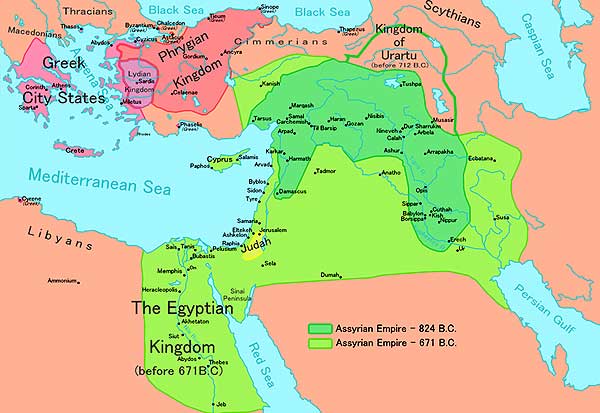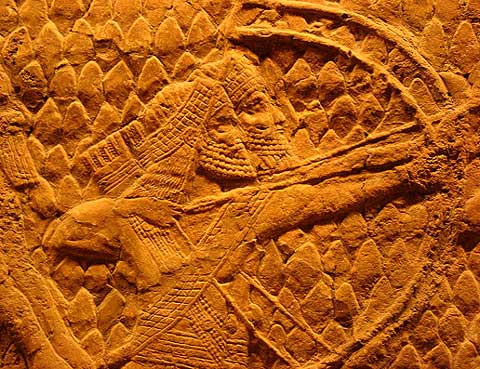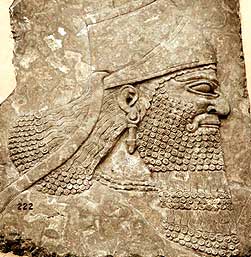

Mesopotamia, though fed by two huge rivers, ultimately provided a lesson that few more recent states have taken seriously. From the very beginning of Uruk, writings from Sumerian states show that agricultural matters, food allocation, and food rationing were serious concerns, as was providing labor to keep the irrigation channels free of silt. As populations of various city-states grew, part of the problem was competition for productive soils, and the difficulties posed by climate and irrigation.
Droughts often motivated the military expeditions of one city-state against another in the often confusing history of Mesopotamia. Ultimately however, it was the increasing salinization of the soil that posed a problem Mesopotamia could not solve. The groundwater in semi-arid regions such as Iraq tends to contain high quantities of dissolved salt; where the water table is high, as it is near rivers, the groundwater moves up via evaporation, leaving the salt in the soil. While initially the land can be irrigated, and is very productive, sustained irrigation combined with high evaporation rates left more and more salt in the soil, lowering productivity. The only way to prevent this was by irrigating in moderation, or letting land lie fallow (unplanted) for long periods of time. As population continued to rise in Mesopotamia, this was not an option that any state could follow. As is so often the case, people sacrificed their long-term well being for short term gains, and sought to improve their own situation by conquering their neighbors.
In southern Mesopotamia in 3,000 BC, equal amounts of barley and wheat were grown. Wheat however proved much less salt-tolerant than barley, and by 2,500 BC wheat provided less than a fifth of the grain harvest. By 2,000 BC, wheat could no longer be grown in southern Mesopotamia. Without the grain to support large armies, southern Mesopotamia continued to decline in importance compared to the more northerly areas. Two of these areas were the city of Babylon, considerably north of Uruk and Ur on the Euphrates River, and Assur further north on the Tigris River, which became one of the important cities of the Assyrian Empire.
Babylon became the primary city of Mesopotamia by 1792 BC, and retained control of much of the area for almost 200 years. At one point in time, Babylon probably reached a population size of close to 200,000, the first city to ever do so.

Map of Babylonian Empire, ca. 1790 BC
Babylon is strongly associated with its major king, Hammurabi (1792-1750 BC), who is credited with writing down and clarifying laws that were already in effect. Reading this Code of Hammurabi provides the most complete information on culture of the time, since almost any possible human behavior appears to be covered. What we would call major crimes were almost invariably punished by death. Below are a few of the crimes and punishments listed in the Code.Click here (highly recommended) and then scroll down near the bottom to read at least part of the 282 "laws" in the complete Code.
If a son strike his father, his hands shall be hewn off.
If a man put out the eye of another man, his eye shall be put out. [ An eye for an eye ]
If he break another man's bone, his bone shall be broken.
If he put out the eye of a freed man, or break the bone of a freed man, he shall pay one gold mina.
If he put out the eye of a man's slave, or break the bone of a man's slave, he shall pay one-half of its value.
If a man knock out the teeth of his equal, his teeth shall be knocked out. [ A tooth for a tooth ]
If he knock out the teeth of a freed man, he shall pay one-third of a gold mina.
If any one strike the body of a man higher in rank than he, he shall receive sixty blows with an ox-whip in public.
Babylon clearly provided the origin of the Bible's Old Testament eye for an eye, tooth for a tooth approach to justice.
Babylon declined in importance as trade to the north gained in importance, as did the northern groups of Hatti (the Hittites) and Metanni (somewhat to the east). With the collapse of the Hittites (primarily due to a prolonged drought) the Phoenicians on the Mediterranean coast became central to trade with Egypt and the Mycenaean. Ultimately, Assur and Babylon temporarily gained importance for Mesopotamia once again.
The Assyrians, centered on their cities of Assur and Nineveh in what is now northern Iraq, had long been involved in the trade and power struggles of northern Mesopotamia and beyond. They began a series of conquests, moving west and south, by 1116 BC, when Assyrian dominance extended to Syria. In 729 BC they finally captured Babylon, and by 722 BC had conquered the small northern Hebrew kingdom of Israel. Assyria kept on moving south to capture Memphis and the Egyptian delta region by 671 BC. As obvious from the map below, for a time the Assyrian Empire controlled more territory than any previous group in the region. Only the small Hebrew state of Judah (centered on Jerusalem) put up such a fierce resistance that they remained apart from though surrounded by the Empire.

Assyrian Empire
The Assyrians were aided by their use of iron weapons, included swords and lances, and they wore metal armour into the field. When they conquered an area, survivors were often deported to other parts of the empire. The Assyrians also made advances in mathematics, dividing the circle into 360 degrees, and were among the first to invent latitude and longitude as aids to geographical navigation. The last major ruler, Ashurbanipal, had as a major project assembling all the literature of Mesopotamia in a library in the city of Nineveh; as part of this project, Assyrian scribes recorded the Epic of Gilgamesh. Over thirty thousand clay tablets still remain of this library, providing an enormous resource on Mesopotamia.

Assyrian Archers, part of the Empire's standing army, mostly of conscripts

Ashurbanipal
Assyria increasingly faced internal revolts, and its enemies combined behind Babylon. Nineveh was sacked and burned in 612 BC. Babylon once again, though briefly, became an important power in the region.
The new Babylonian Empire, sometimes referred to as the Chaldeans, took control over much of the old Assyrian Empire. They succeeded in conquering the state of Judah and in 587 BC, destroyed Jerusalem. Following Assyrian practice, a large part of the Hebrew population was deported and held in captivity in Babylon. Under the king Nebuchadnezzar, Babylon was rebuilt with renewed splendor; however in 539 BC Babylon was conquered by Persia. (more on Persia in a later lesson) Babylon had used its conquered peoples like the Hebrews to dig mud from the irrigation ditches. In some cases, the piled silt and mud reached over 30 feet high on each side of the irrigation channels. Ultimately, Babylon could not water its fields and the salty fields could not support its population. Mesopotamia, which for 3000 years had controlled or influenced southwest Asia and the Mediterranean, was to remain under the control of one foreign power after another, and its importance remained slight, until the rise of industrialism and the new world dependence upon oil.

The Ishtar Gate, one of eight gates into Nebuchadnezzar's Babylon [reconstructed in the Pergamon Museum in Berlin, Germany. From The Last Two Million Years, Reader's Digest Association, 1973. p.59]
![]()
Lion on the Ishtar Gate [Public domain]